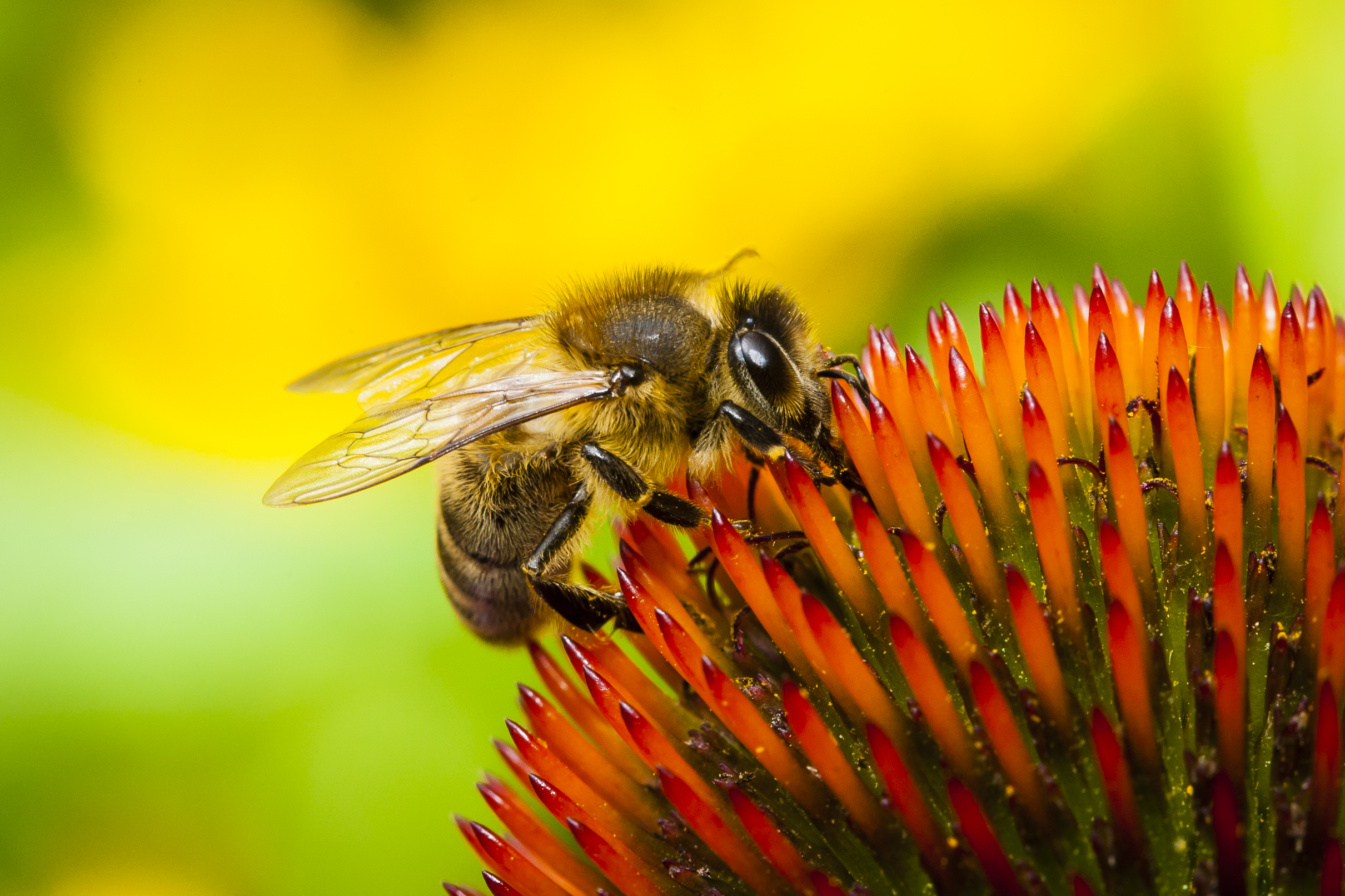As all around the world, an important proportion of bees are dying in Turkey too. If we don’t take the necessary steps in the near future, not just bees but all other species who are living together in the unique diversity of life and our food will be in danger.
Bees are not just producing honey, they are responsible of the one third of the foods that we are eating. Bees help the reproduction and diversification of plants by pollinating them while wandering around the flowers. 80% of this process called pollination is done by bees and wasps. Bees, together with other insects ensure the sustainability of biodiversification. In other words, a world without bees is not possible.
Why Bees are Dying?
Uludağ University Bee Research Center indicates that the normally constant 20% mortality rate goes up to 70% in some regions and number of bee deaths is raising all across the country1.
The primordial reason behind this decrease of the bee population is the chemicals employed in agricultural production, called largely pesticides2. Scientific research shows that particularly neonicotinoid class pesticides might have lethal impact on the bees and also, they might cause paralysis, amnesia, and other malfunctions of biological system by affecting the neural system of the bees. Nicotine mechanism based these pesticides are poisoning neural systems of living creatures. In addition to this, other problems such as global climate change, loss of habitats and, false apiculture practices are also participating to bee deaths.
A research conducted in Turkey between 2012 and 2016 reveals out that, particularly in Tekirdağ and Edirne, 25% of the soil examples from sunflower fields and 35% of the sunflower flowers contain imidacloprid which is a type of neonicotinoid. The same work also determines that nearly half of the examples from flowers contain a high level of residuals which can poison the bees3. A research made in Switzerland gathered honey examples from 198 local producers all around the world. They detected that 75% of these honeys contain neonicotinoid class insect killer4 (even though the chemical residuals are lower than the legal limits in the EU and USA).
Banned in Europe, Legal in Turkey!
Neonicotinoids put life as whole in a serious danger. Insect killers and other pesticides induce a disease called “Colony Collapse Syndrome” which results with bee deaths. These chemicals can be applied directly to the roots of the plants therefore while plants grow up, these chemicals remain in it. Insects who contact with the plant die by poisoning5. Other researchers prove that beside bees, these insect killing chemicals have an impact on the birds6, butterflies7, and invertebrates living under water8. Moreover, a huge part of the neonicotinoids which applied to plants tangle in to the soil and they rest in it without losing their nefast effects up to 19 years. Consequently, it is quite hard to determine which living creatures are affected and the amount of the damage caused by these chemicals. Nevertheless, all the new developments about this issue prove the fatal effects of neonicotinoids on ecosystems. In 2018, European Union accepted a proposal which bans the use of three substances from neonicotinoid class except from greenhouse usage. The ban will be implemented until the end of 2018. These neonicotinoids (imidacloprid, clothianidin and thiamethoxam), which is banned in Europe, are still used freely and broadly in Turkey
Ban the Neonicotinoids!
To stop the bee deaths and to let them live, there are many steps to take. We, as the civil society organizations who signed this declaration, believe that the first step should be taken by the Ministry of Agriculture and Forestry. We demand a ban to neonicotinoids which are directly responsible of these deaths and an efficient and regular audit about the topic.
We believe that banning the neonicotinoid class pesticides to protect the biodiversity and the food security in Turkey is a necessary and essential first step.
Human is just another creature in the nature. It is possible to produce without hurting, ruining, poisoning the nature and to live together with a harmony along with all other species by the circular logic of nature. In the hope of a world without need of protection the nature…
Signatory Organizations:
Buğday Ekolojik Yaşamı Destekleme Derneği
Çevre ve Arı Koruma Derneği (ÇARIK)
Çevre ve Kültür Değerlerini Koruma ve Tanıtma Vakfı (ÇEKÜL)
Doğa Derneği
Doğa Koruma Merkezi (DKM)
Greenpeace
Kuzey Ormanları Savunması (KOS)
Türkiye Arı Yetiştiricileri Merkez Birliği (TAB)
WWF-Türkiye
Yeryüzü Derneği
Yeşil Düşünce Derneği
Footnotes
1. AGAM “Türkiye’deki Arı ölümleri Kaygı Verici Boyutlarda.” Bursa Uludağ Üniversitesi. Eylül 14, 2015. Accesed at December 05, 2018. https://uludag.edu.tr/haber/view/136.
2. Pestisit: Gıda maddelerinin üretimi, tüketimi, depolanmaları esnasında gıdalara zarar veren mikroorganizma ve zararlıları uzaklaştırmak veya yok etmek amacıyla kullanılan, kimyasal ya da biyolojik ürünlerin tümüne pestisit adı verilmektedir. Açar, Ö. Ç. “TC Gıda, Tarım ve Hayvancılık Bakanlığı Ulusal Gıda Referans Laboratuvarı Eğitim Notu Pestisit Analizleri.” Temmuz 2015.
3. Ünal ve ark. “TAGEM/HSYGAD/12/A06/PO3/13 nolu Bal arılarında neonicotinoid grubu insektisitlerin toksikasyonlarının araştırılması adlı projenin sonuç raporu” (2016).
4. Mitchell, E. A. D. ve ark. “A Worldwide Survey of Neonicotinoids in Honey.” Science, 358/6359 (2017), s. 109–111. doi:10.1126/science.aan3684.
5. Greenpeace Akdeniz. “Arılar Yaşasın Diye: Dünyada ve Türkiye’de Tozlamayı Yapan Canlıları ve Tarımı Tehlikeye Atan Faktörlere Dair Bir Değerlendirme.” September, 2018.
http://www.greenpeace.org/turkey/Global/turkey/report/2018/arilar-yasasin-diye.pdf
6. Eng, Margaret L., Bridget J. M. Stutchbury, ve Christy A. Morrissey. “Imidacloprid and Chlorpyrifos Insecticides Impair Migratory Ability in a Seed-eating Songbird.” Scientific Reports 7, no. 1. November 09, 2017. doi:10.1038/s41598-017-15446-x.
7. Forister ML ve ark. “Increasing Neonicotinoid Use and the Declining Butterfly Fauna of Lowland California.” Biology Letters.12: 20160475 (2016). http://dx.doi.org/10.1098/rsbl.2016.0475
8. Wood, T. ve Goulson, D. “The Environmental Risks of Neonicotinoid Pesticides: A Review of the Evidence Post 2013.” Environmental Science and Pollution Research, 24(21), (2017). s.17285-17325.
9. Goulson, D. “An Overview of the Environmental Risks Posed by Neonicotinoid Insecticides.” Journal of Applied Ecology. 50/4 (2013). s. 977–987.


